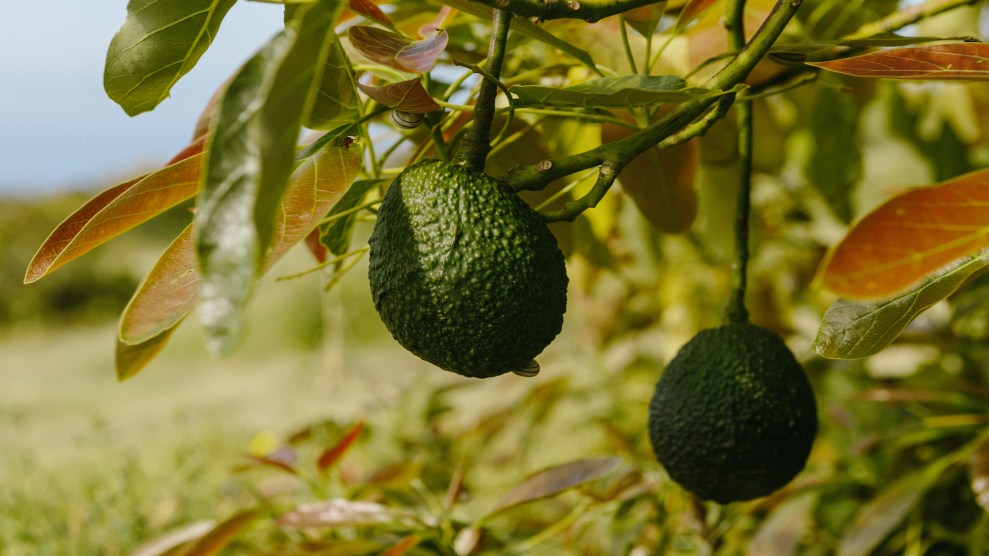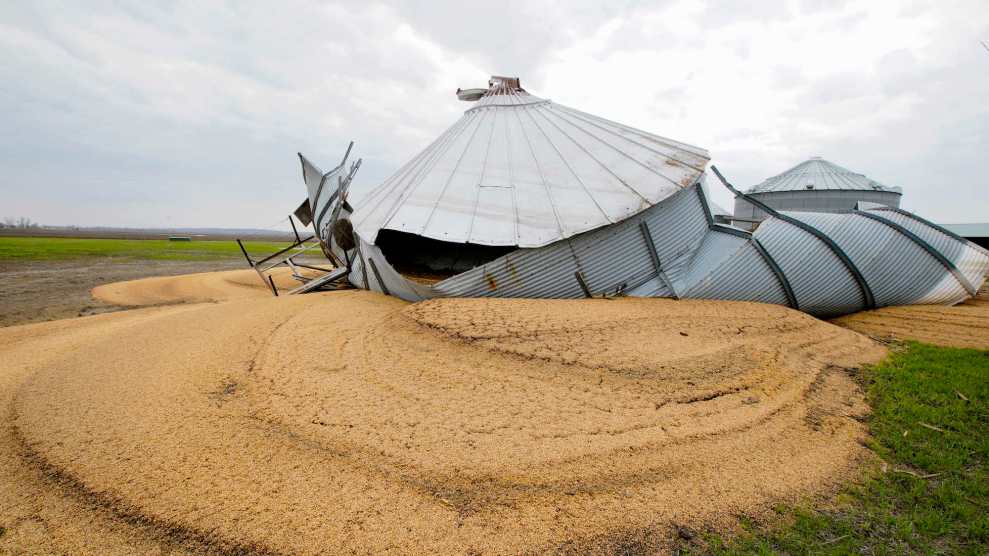
Avocados hang from a tree on a farm in Rancho Palos Verdes, Calif.Patrick Record / Getty
This piece was originally published by Capital & Main.
The writer Upton Sinclair once famously said, upon the reaction to his classic exposé of the slaughterhouse industry, The Jungle, “I aimed at the public’s heart, and by accident I hit it in the stomach.” He thought he was writing a book exposing the horrendous conditions for workers, and instead ignited outrage over the plight of the unsanitary slaughtering of animals and contamination of the meat.
When it comes to reporting on the climate crisis, let’s aim for the stomach instead of getting to it accidentally, as Sinclair did. Accelerating climate volatility is shining a harsh light on the frailty of our industrial food system. Usually with climate change we talk about heat, but let’s talk about the cold, or the lack of it. We humans may not like the cold, but a lot of fruit trees do. Cherries, apricots, peaches and some other tree fruits need the nighttime temperatures to drop during the winter, from December-February, in order to slow their metabolism—a sort of winter hibernation—to conserve energy before ripening in the spring. In California’s Central Valley, the nation’s leading producer of those and dozens of other different fruits, the cascade that starts with greenhouse gas pollution has been leading to dramatic drops in the number of what are known as winter chill hours. As a result, yields of those and other fruits are tapering off or the quality is declining.
In other food-growing regions of the United States, a similar process of winter warming is underway, as illustrated in this handy guide from Climate Central. Over the next 15 years, at least 23 states will experience significant decreases of at least two weeks or more in the number of freezing overnight temperatures. Some of those states, such as Kansas, Nebraska, Iowa and Illinois, are major grain producers and are discovering that the later, and warmer, onset of winter is providing an entry point to pests and their offspring that otherwise would have been killed by what used to be the post-summer cold weather.
And how about foods we may not grow here in the U.S., but most definitely consume on a major scale? Choose your crop, or just work your way through the day.
Morning: Coffee. The beans will be getting more rare, and expensive, as their range shrinks due to climate changes in Colombia. Coffee growing regions in Central America are experiencing similarly shrinking coffee friendly terrain as the temperature rises and rainfall drops. Also, there’s an angle here on the perceived immigration crisis: The degradation of landscapes, many of them in what used to be coffee growing regions in Guatemala and Honduras, has compelled small farmers, no longer able to sustain themselves on the land, to join the ranks of displaced people and head north toward the U.S. frontier.
Afternoon: Avocado? Yields are expected to drop significantly over the coming 20 years, and yields of almonds, walnuts, cherries, oranges and table grapes are also expected to drop under current California climate scenarios.
Evening: Chocolate? Major areas of chocolate cultivation in West Africa are getting warmer, and thus, according to NOAA, less hospitable to the cacao trees that Senegal, Ivory Coast and other countries in the region have relied upon to supply raw material to American and European chocolatiers.
Stories about these and other crops lost to the disrupted climate certainly have the potential to hit home. The climate attribution science is getting better and better at identifying the precise ways in which the human factor — i.e., greenhouse gases — contributes to these conditions.
The big underlying story behind the vulnerability of U.S. agriculture to climate extremes is the dramatic consolidation of control within U.S. agriculture. Just four chemical companies — only one of them American — control more than half of all commercially traded seeds planted globally. Those companies include Corteva, which was spun off from the formerly merged Dow and DuPont; Monsanto, owned by the German pharma and chemical giant Bayer; Syngenta, owned by one of China’s biggest chemical companies, ChemChina; and BASF, another German agrichemical giant.
All sell seeds that are bred to be dependent for their survival on the chemicals produced by the mother company; the companies profit from both ends of that deal (as I reported in my book Seeds of Resistance: The Fight for Food Diversity on Our Climate-Ravaged Planet). Those seeds, born addicted to agrichemicals, are largely unable to adapt to changing conditions.
One result, as has been recorded in numerous scientific journals — including from North Dakota State University and from UC Merced — have been dramatic declines in biodiversity as more and more American farms are planted with chemical-dependent monocrops that have little ability to adapt to the changing conditions.
There are versions of that story in every agricultural community in the United States — including in those attempting to buck this trend by prioritizing the use and preservation of locally adapted seeds, which are showing far more resilience to climatic shifts than the mass-produced seeds of the agrichemical giants.
And how does this connect to the other side of the coin, agriculture’s contribution to climate change? Agriculture is responsible for at least 11% of all greenhouse gas emissions in the United States, according to the USDA — including methane (cattle and crop tillage), nitrous oxide (nitrogen-based fertilizers) and carbon dioxide (transport and fuels for mechanized agriculture), and the use of petrochemicals to create many of the most popular pesticides and herbicides. As the United Nations has grown more concerned about agriculture’s greenhouse gas contributions, the number of “Big Ag” lobbyists and representatives more than doubled during the recent Sharm el-Sheikh climate talks from the number who attended the previous year at the Glasgow climate conference.
There seems to be another common thread between agriculture and climate in the United States: the proliferation of disinformation. Earlier this month, U.S. Right to Know, which specializes in obtaining internal corporate documents via freedom of information requests and other means, released an eye opening report revealing the many links between public relations firms defending the use of Monsanto’s RoundUp herbicide — a suspected carcinogen and key ingredient in the company’s “climate smart” marketing strategy — and those that promoted unfounded doubts about climate change and the carcinogenicity of tobacco.
The Climate Tit For Tat
Growing food may be the most severe example of the two sides of the climate coin — for farmers both contribute to climate change and are on the front lines of its most destructive implications. But look around and there are many two-sided coins in this multidimensional climate crisis, some of them almost tragi-comic.
A group of Wyoming state legislators introduced a bill in early January that would call on the state to “phase out” electric vehicles by 2035. The bill, described as the oil- and coal-rich state’s response to California’s new initiative to phase out all gasoline-only powered cars by 2035, is now being considered by the Wyoming Legislature. It would likely be symbolic if passed — but suggests that anyone driving with a California e-vehicle would likely have to detour around the state in which there would be very few charging stations.
Meanwhile, the efforts by six Southern states to pass laws blocking state funds from being invested with firms that have indicated their willingness to impose sustainability criteria on their investments face hundreds of millions of dollars in losses, according to a new report just out from the Sunrise Project. This effort in several states to limit government funds from being channeled into ESG-friendly investments was a theme of the very first of these columns. Now, four months later, the data is in: If they follow the example of Texas and prohibit state funds from being deposited with such ESG (Environmental, Social and Governance)-sensitive investment vehicles, the states of Kentucky, Louisiana, Florida, West Virginia, Missouri and Oklahoma face hundreds of millions of dollars in potential losses due to limiting their investment options and increased interest rates on state-issued bonds.
In a backhanded way, this opens the door for some possibly enlightening reporting on why funds invested with fossil fuel-friendly funds would be at a disadvantage when compared with those consciously blocking such investments.













